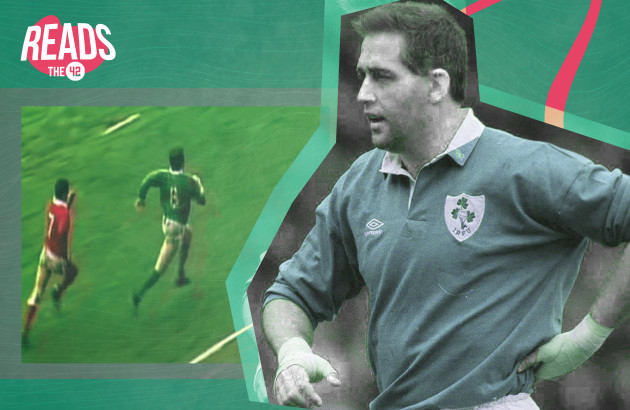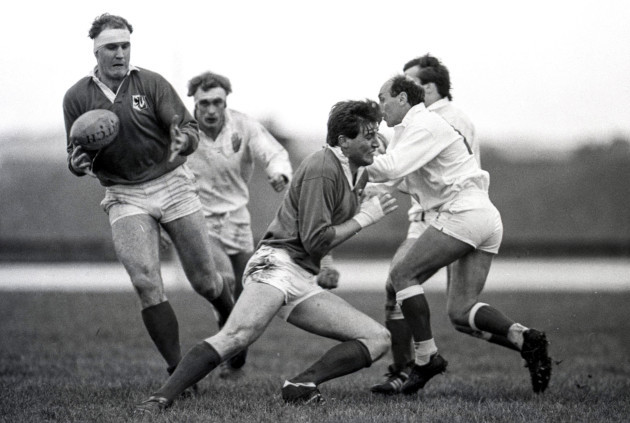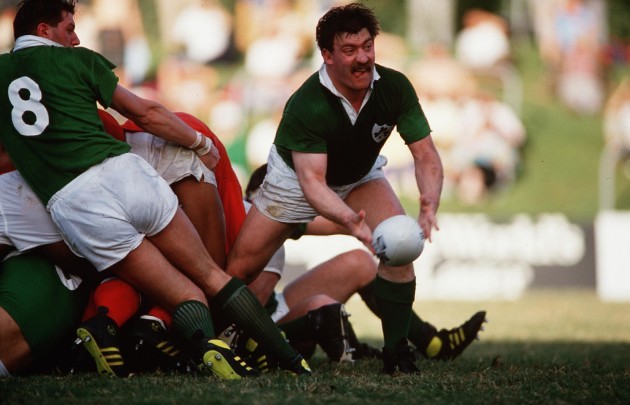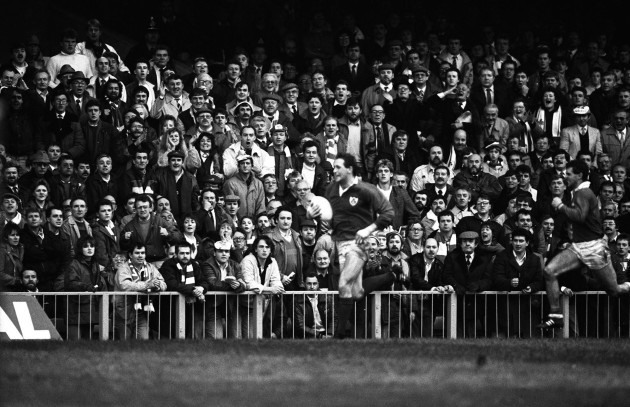THE OBVIOUS THING is to talk about that try, the most iconic chase of the Irish sporting decade, with all due respect to Dawn Run and Cheltenham ’86. But we’re not going there. “Well thank God for that,” says Noel Mannion. “The story has been flogged to death.”
Others have still to be told. To start with, there was this shivery feeling that travelled down his spine, when he sat in his front room watching Reeling in the Years this time last year. Images and sounds from long ago, burning cars, screaming voices, bloodied faces.
Towns that didn’t feature on too many tourist brochures: Dungannon, Portadown, Ballymena, Bangor, Ards. Rugby brought Noel Mannion to every one of them. “And I never once batted an eyelid about going there. I loved it.” He repeats the words like Kevin Keegan. “Loved it.”
It’s only now he considers the dangers, the perils of driving his southern registered car through villages and towns where a car number plate said a lot about who and what you were. The first year he went up there, 83 people lost their lives in The Troubles. By the time he played his final game in Ulster, 14 years later, that number had dipped to 20.
Being a good rugby player, he knew how to sidestep trouble.
Others weren’t so lucky. He played against Nigel Carr, never alongside him. But they were friendly, the way so many players were in that era. “The fixture list was a bit of a mess,” Mannion says, remembering the itinerary that international and interprovincial players had to put up with in the 1980s.
- For more great storytelling and analysis from our award-winning journalists, join the club at The42 Membership today. Click here to find out more >
Pre-season, for Galway clubs anyway, started the week after The Races, easing into a campaign that began in September and came to a conclusion in March ‘sometimes April if you reached a cup final’.
Along the way competitive fixtures were sporadic, a couple of Connacht senior league games in October and November which was when the inter-pros would begin, January bringing a Final Trial before the Five Nations. And if you were lucky – which he was from 1988 to 1991 – you’d get an international fixture to break up the autumn. Otherwise, there were weeks and weeks when the diary was empty.
Filling the gaps entailed filling the tank with diesel and heading north for a succession of friendlies against a variety of Ulster teams. “When I see the footage of the devastation the (Ulster) people went through in those decades, part of me thinks, what in the name of Jaysus were we doing, going up there, into a warzone, right in the centre of where the conflict was, just to play rugby.
“We didn’t know the half of what was going on but never once did I feel vulnerable. And in all fairness to the lads (their Ulster opponents) they minded us. We’d go to a disco or whatever but they’d never bring us anywhere where there might be bother. All I remember is craic. There’d be fellas loading the car boot with drink to take home because alcohol was way cheaper in the North. I suppose you’d call it smuggling now (laughs). Ah the whole weekend was just brilliant fun.”
It was a perfect world. They always played to win; yet there was never any pressure to do so. Now and then a Connacht selector would show his face to see how the next big thing was shaping up but by and large, the 1980s Irish rugby international only had to worry about playing hard on a Saturday afternoon and partying harder on a Saturday night. “Any time we played an Ulster side, we stayed over. No question.”
One side were catholic, the other protestant but at no point did any of them discuss labels or politics, not when the important issues of drinking and rugby were on the agenda. “When I went up there first, I was 19, 20, and some of the older heads on the Corinthians team would have pulled you to one side for a word: ‘Don’t think it is funny to sing a rebel song in a pub, don’t talk about stuff (political issues)’. In no uncertain terms you were told that there was a certain way of behaving.”
Yet there are regrets. He wishes he could turn back the clock and test his inquisitive mind, to see how unionists were shaped by the events of that era. “It was not out of ignorance that we stayed silent,” Mannion says. “It was just a taboo subject. It never came up. We became close friends with so many of the (Ulster) players we met; guys from the North were at my wedding. I’m still in touch with loads of them. Still, I’ve never had one conversation with any (of them) about politics.”
After first battering into them as a young Corinthians forward in 1982, Mannion stepped onto a bigger stage in ’85, when Connacht called. Success was rare. By the time he had retired, he had notched up just two wins against Leinster, and another pair of victories over Munster, with nothing bar a draw to show for his tussles against Ulster, then Ireland’s dominant side.
Still, he left an impression on their coach and by the time Jimmy Davidson was venturing south to succeed Mick Doyle as Ireland coach, Mannion had become perhaps the hardest working player in provincial rugby, working out with his local GAA team during the summer, hitting the gym in the winter. “Some people thought Jimmy was eccentric, but the man was ahead of his time,” Mannion says. “And on a personal level, I loved playing for him. He was always good to me.”
To the extent that one night, midway through 1987, Davidson called Mannion at home. “Noel, if you want to play Gaelic football, best of luck to you, it’s a great sport. But if you’re serious about rugby, let me know.”
Mannion made the call and a year later, he walked into the changing room underneath the old West Stand at Lansdowne Road to take his seat next to two Ulstermen, Denis McBride and Philip Matthews. Jimmy McCoy, a prop, was to his left, reading the match programme. “Jimmy was quiet before games.”
There was a good reason why he kept his head down. Way back then, professions were sometimes listed in the programme next to a player’s name. Mannion was a sales rep, McCoy and the reserve hooker, Johnny McDonald, ‘civil servants’. “Little did we know the turmoil that the likes of Jimmy and Johnny (who in actuality were serving RUC men) went through. They took a fair old risk doing what they did, crossing the border. To stand for Amhrán na bhFiann and then on a Monday morning get back in their car and drive north, I have huge respect for that.
“And as I get older, the respect deepens because when you think about it, they must have been vilified by some of their own people for standing for our national anthem and were possibly never fully trusted by some nationalists. I don’t know whether they went against their political principles (to play for Ireland and stand for the national anthem). Now, for today’s Ulster players, it is a job. Play for Ireland, your salary goes up. But back then, it wasn’t for money. The Ulster lads had a choice and they chose Ireland, chose Irish rugby. How could you not admire people for doing that?”
The outlook he has on life as a middle-aged man has broadened in contrast to his younger self. It’s a common trait among sportspeople. “We could be one dimensional, no doubt,” he says.
Yet they were neither blind nor stupid. At the team’s Westbury Hotel, special branch officers would patrol the corridors, nosing around corners, checking out any potential threat to McCoy and McDonald. “They melted into the group, were so friendly; they knew their job. There was no bravado. It is not as if they were wearing trench coats and f***ing sunglasses. It was casually done.”
So much was in that era. During the ’85 Triple Crown season, there was this eve-of-match tradition, where the forwards and backs separated for pre-match meetings, the pack heading to O’Donoghue’s on Baggot Street for pints, the backs to the dining room for tea and sandwiches. But under Davidson, it became a lot more professional. “Weight programmes, video prep; the things we ate. Some older players resisted, insisting on having a steak before a game.”
There was another important pre-match adjustment.
“We started to go Lynch’s (a pub off Grafton Street) rather than O’Donoghue’s,” says Mannion.
The night before the game?
“Yup.”
Every game?
“Just for a pint, two at the very most.”
The logic was that this was where they’d get to know one another that bit better. “We’d talk about families, our backgrounds, what we did for a living, that sort of stuff.”
The year Mannion made his debut was the year after Carr was badly injured in a border bombing just outside Newry when the IRA blew up the car of Maurice Gibson, a Lord Justice. Carr, Davy Irwin and Philip Rainey just happened to be travelling the opposite direction for an Ireland training session when the bomb went off. Carr’s injuries prevented him playing for Ireland again.
“That bomb woke up the southern lads to the realities of the North, made us sit up and say ‘f***ing hell, this is what these guys are facing’. You don’t want to think about what would have happened had ……”
The sentence is left unfinished.
“Where would Irish rugby have gone afterwards?”
He never had that discussion. Despite his curious mind, the only things he talked about with McCoy, McDonald, Matthews, Irwin, Steve Smyth and his closest pal of them all, Keith Crossan, were the things fellas all around the world discussed.
They’d get to know one another better between 1988 and 1993, Mannion winning the first of his 16 caps against Samoa in October ’88. Then, a few months later, it was France in the Five Nations.
He remembers calling in home that week; recalls the walk down the street, the car horns hooting as people recognised one of their own back on Ballinasloe’s main street. There’s always something magical about a local-boy-done-well story in a provincial town. Ray McLoughlin had walked that same street before him and Mannion had heard all the stories about Ray.
Now it was him.
As a club player, playing in those friendlies in the North, or in the 10-game Connacht senior league season, crowds would rarely venture north ‘of a few hundred’. Now there were 55,000 pairs of eyes watching him and that’s before you add in the millions tuning in on TV.
Ravenhill and Thomond Park conditioned him to bigger days, gifting him ‘a gentle nudge into what it was like to play in front of a crowd’. “Thomond Park, the comments you’d hear from the terraces were brilliant. They’d cut the ground from under you with a sharp assessment of your faults. You learned.”
Still, it was no preparation for his fourth cap.
Cardiff, the Arms Park.
Look at the picture above, you can see the crowd and sense the noise as Mannion races away from David Bryant, the Wales openside, en route to the tryline.
He remembers that day as clearly as yesterday, the bus crawling through Cardiff’s tight streets, the throngs spilling out of pubs, raising their pints and fists as they saw the bus pass.
It saddens him that Ireland’s players won’t sample that atmosphere tomorrow, just as he worries about other aspects of their modern-day rugby experience, the concussion fears, the threat over pay-cuts and new contracts; the reliance rugby has on television companies.
If there was one day he could relive it would be that one at the Arms Park, fully loaded with the Welsh supporters, the noise coming out of 60’000 throats as he smuggled Bleddyn Bowen’s kick.
“I didn’t have a particularly good game that day. Mark Jones, my opposite number, he scored a try as well and had a much better game which is forgotten about.”
But you’ve probably heard that story before.
We won’t go there.





